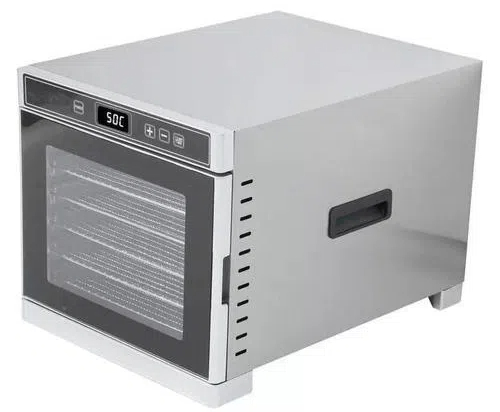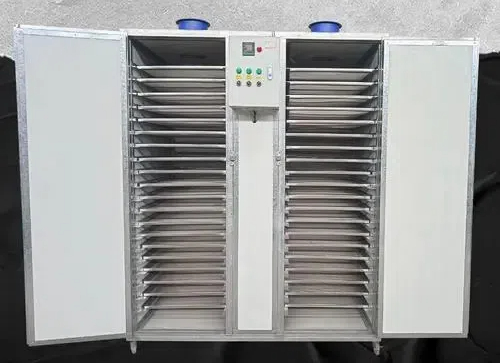
Content Menu
● Understanding Heat Pump Dryers
>> How Heat Pump Dryers Work
● Installation Requirements
● Step-by-Step Installation Process
● Benefits of Heat Pump Dryers
● Common Misconceptions About Heat Pump Dryers
● Maintenance Tips for Heat Pump Dryers
● Conclusion
● FAQ
>> 1. What is a heat pump dryer?
>> 2. How much space do I need around my heat pump dryer?
>> 3. Can I install a heat pump dryer in a small laundry room?
>> 4. Do I need special electrical outlets for my heat pump dryer?
>> 5. How often do I need to empty the water reservoir?
Heat pump dryers are becoming increasingly popular due to their energy efficiency and ability to dry clothes without venting hot air outside. However, proper installation is crucial for optimal performance. This article will explore the installation requirements for heat pump dryers, particularly focusing on food dehydrators, which share similar principles in drying technology.

Understanding Heat Pump Dryers
Heat pump dryers utilize a refrigeration cycle to remove moisture from clothing. Unlike traditional dryers that expel hot air and moisture, heat pump dryers recycle air within the unit. This process not only saves energy but also reduces the need for external venting, making them suitable for various environments.
How Heat Pump Dryers Work
Heat pump dryers operate by using a heat exchanger that absorbs moisture from the air inside the drum. The warm, moist air is then passed through the heat pump system, where it is cooled down, causing the moisture to condense into water. The dry air is then reheated and returned to the drum to continue the drying process. This cycle repeats until the desired moisture level is reached.
Installation Requirements
When installing a heat pump dryer, several key requirements must be met to ensure efficient operation:
Location Selection
- Dry and Ventilated Area: The dryer should be placed in a dry, well-ventilated area to prevent moisture buildup. Avoid areas prone to dampness or direct sunlight.
- Space Around the Unit: Ensure there is adequate space around the dryer for airflow. Typically, a clearance of at least 10-15 cm from walls is recommended.
- Level Surface: The dryer must be installed on a flat and stable surface to minimize vibrations and noise during operation.
- Temperature Considerations: Ideally, the installation area should maintain a temperature range between 5°C and 35°C (41°F to 95°F). Extreme temperatures can affect the dryer's efficiency and performance.
Electrical Requirements
- Power Supply: Ensure the dryer is connected to a suitable power supply that meets the manufacturer's specifications. Most heat pump dryers require a standard 220-240V outlet.
- Grounding: Proper grounding is essential for safety. Make sure the electrical outlet is grounded according to local electrical codes.
- Dedicated Circuit: It is advisable to have a dedicated electrical circuit for your heat pump dryer to prevent overloads and ensure consistent performance.
Drainage Needs
- Water Drainage: Heat pump dryers collect moisture in a reservoir or require a drainage hose. If using a hose, ensure it leads to an appropriate drain.
- Reservoir Management: If your model has a water reservoir, it should be easily accessible for regular emptying. Some models may have an indicator light that alerts you when the reservoir is full.
Ventilation Considerations
- No External Venting Needed: Unlike traditional dryers, heat pump dryers do not require external venting. However, ensure that the internal air circulation is unobstructed.
- Air Intake: Make sure that the air intake and exhaust are free from obstructions to allow efficient airflow.

Step-by-Step Installation Process
1. Choose the Right Location: Select a dry, ventilated area with enough space around the dryer.
2. Prepare Electrical Connections: Ensure that the power outlet meets specifications and is grounded.
3. Set Up Drainage: Decide whether to use the water reservoir or connect a drainage hose.
4. Position the Dryer: Place the dryer on a level surface, ensuring it is stable and secure.
5. Test Functionality: Once installed, run a test cycle to ensure everything operates correctly without unusual noises or errors.
6. Adjust Settings: Familiarize yourself with the control panel settings and adjust them according to your drying needs.
Benefits of Heat Pump Dryers
Heat pump dryers offer numerous advantages:
- Energy Efficiency: They consume significantly less energy compared to conventional dryers due to their recycling of hot air, which can lead to lower electricity bills over time.
- Gentler Drying Process: The lower drying temperatures are gentler on fabrics, reducing wear and tear and extending the lifespan of your clothing.
- Versatility: Suitable for various types of fabrics and materials, including delicate items such as silk or wool that might be damaged by high heat.
- Environmentally Friendly: By using less energy and not requiring venting systems that can release heat outdoors, heat pump dryers are more environmentally friendly than traditional models.
Common Misconceptions About Heat Pump Dryers
Despite their growing popularity, several misconceptions surround heat pump dryers:
- They Take Longer to Dry Clothes: While it's true that heat pump dryers may have longer drying times compared to conventional models, they are often more efficient in terms of energy usage during those cycles.
- They Are Expensive to Maintain: Although initial costs may be higher than traditional dryers, their energy efficiency can lead to savings in utility bills over time, offsetting maintenance costs.
- They Cannot Handle Large Loads: Modern heat pump dryers are designed with larger capacities and advanced technology that allows them to handle sizable loads effectively.
Maintenance Tips for Heat Pump Dryers
To ensure your heat pump dryer operates efficiently over its lifespan, consider these maintenance tips:
- Regular Cleaning of Filters: Clean lint filters after each use to maintain airflow and efficiency. Some models may also have additional filters that require cleaning periodically.
- Check Drainage Systems: If using a drainage hose, inspect it regularly for clogs or kinks that could impede water flow.
- Keep Surrounding Areas Clean: Ensure that dust and debris do not accumulate around the dryer's vents or intake areas.
- Schedule Professional Servicing: Consider having your dryer serviced by professionals annually to check for any potential issues before they become significant problems.
Conclusion
Proper installation of heat pump dryers is essential for maximizing their efficiency and longevity. By following these guidelines and ensuring all requirements are met, users can enjoy the benefits of an energy-efficient drying solution that aligns with modern sustainability practices. With their gentle drying capabilities and versatility across various fabric types, heat pump dryers represent an excellent investment for both residential and commercial applications in food drying processes as well as laundry needs.

FAQ
1. What is a heat pump dryer?
A heat pump dryer uses a refrigeration cycle to dry clothes by recycling hot air within the unit instead of venting it outside.
2. How much space do I need around my heat pump dryer?
It is recommended to have at least 10-15 cm of clearance around the dryer for proper airflow.
3. Can I install a heat pump dryer in a small laundry room?
Yes, heat pump dryers can be installed in small spaces since they do not require external venting; however, ensure there's enough space for air circulation.
4. Do I need special electrical outlets for my heat pump dryer?
Most heat pump dryers operate on standard 220-240V outlets; however, always check the manufacturer's specifications for specific electrical requirements.
5. How often do I need to empty the water reservoir?
If your heat pump dryer has a water reservoir, it typically needs to be emptied after every few cycles or when indicated by an alert on the machine.












